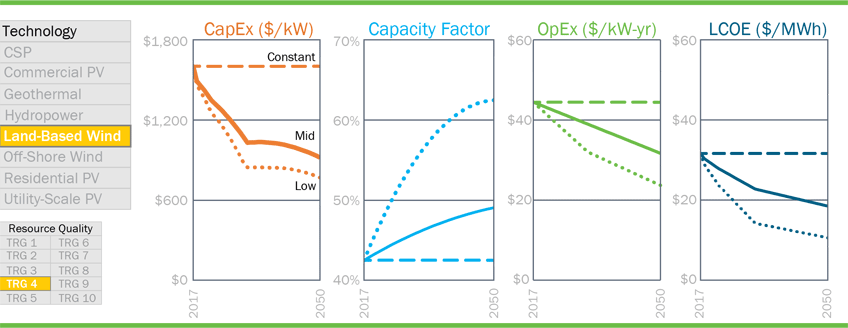Updated Baseline Cost and Performance Data for Electricity Generation Technologies
The U.S. Department of Energy's (DOE's) National Renewable Energy Laboratory (NREL) has released a 2019 update to the Annual Technology Baseline (ATB), a key source of reliable electricity generation technology cost and performance data used to support and inform electric sector analysis in the United States. Now in its fifth year, the ATB documents technology-specific information on a broad spectrum of electricity-generation technologies—including wind, solar, geothermal, hydropower, biopower, coal, natural gas, and nuclear—as well as battery energy storage.
The ATB integrates current and projected data from various sources into a highly accessible and widely referenced resource for energy analysts. The 2019 ATB is available at atb.nrel.gov/electricity and will be featured in a webinar on Aug. 22.
“The Annual Technology Baseline emphasizes development of projections for wind, solar, hydro, and geothermal technologies, and also includes biopower, coal, natural gas, nuclear. This year, we’ve added new information on energy storage data from a literature review. ATB synthesizes key sources of current and projected cost and performance data,” said Laura Vimmerstedt, NREL energy analyst. “ATB looks at the status, the trends, and the range of potential futures for key electricity-sector parameters that energy analysts can use.”
The ATB provides three different levels of future technology cost and performance through 2050 to support analysis of future U.S. electric sector scenarios. This year’s ATB is the first that includes results of the new GeoVision study of geothermal, updated energy storage data from a new literature review, as well as data formatted for easier portability to other applications.

The ATB, which is supported by DOE's Office of Energy Efficiency and Renewable Energy, incorporates NREL and Oak Ridge National Laboratory analysis, data from the U.S. Energy Information Administration, and information from a variety of published reports into three products for energy analysts.
- The ATB Excel spreadsheet documents detailed current and projected cost and performance data for electricity generation technologies.
- The ATB packaged Tableau workbook offers visualizations in Tableau along with summary data in a structured format.
- The website describes each of the technologies and provides additional context for their treatment in the spreadsheet. For each technology, the website provides:
- Historical trends, current estimates, and future projections of three primary cost and performance factors: capital expenditures, capacity factor, and operations and maintenance cost
- Documentation of the methodology and assumptions used to develop the projections of future cost and performance under constant-, mid-, and low-cost cases
- Calculations of levelized cost of energy to illustrate the combined effect of the primary cost and performance factors, using three different sets of financing assumptions.
This work is part of a broader framework introduced by NREL in 2015 to improve the robustness and comparability of electric sector analysis by the laboratory, academia, and other entities in the energy analysis community. The ATB provides inputs for NREL’s Standard Scenarios modeling of the electric sector, which explores a diverse set of potential pathways for U.S. electric sector evolution over time, based on different assumptions about fuel prices, policies and other variables.
The Annual Technology Baseline will be presented in a webinar 1:30–3 p.m. MDT (3:30–5 p.m. EDT) Aug. 22. Presenters will describe analytical products in detail, share examples of how they have been used, and provide an opportunity for attendees to ask questions. Register for the webinar.
Last Updated May 28, 2025
